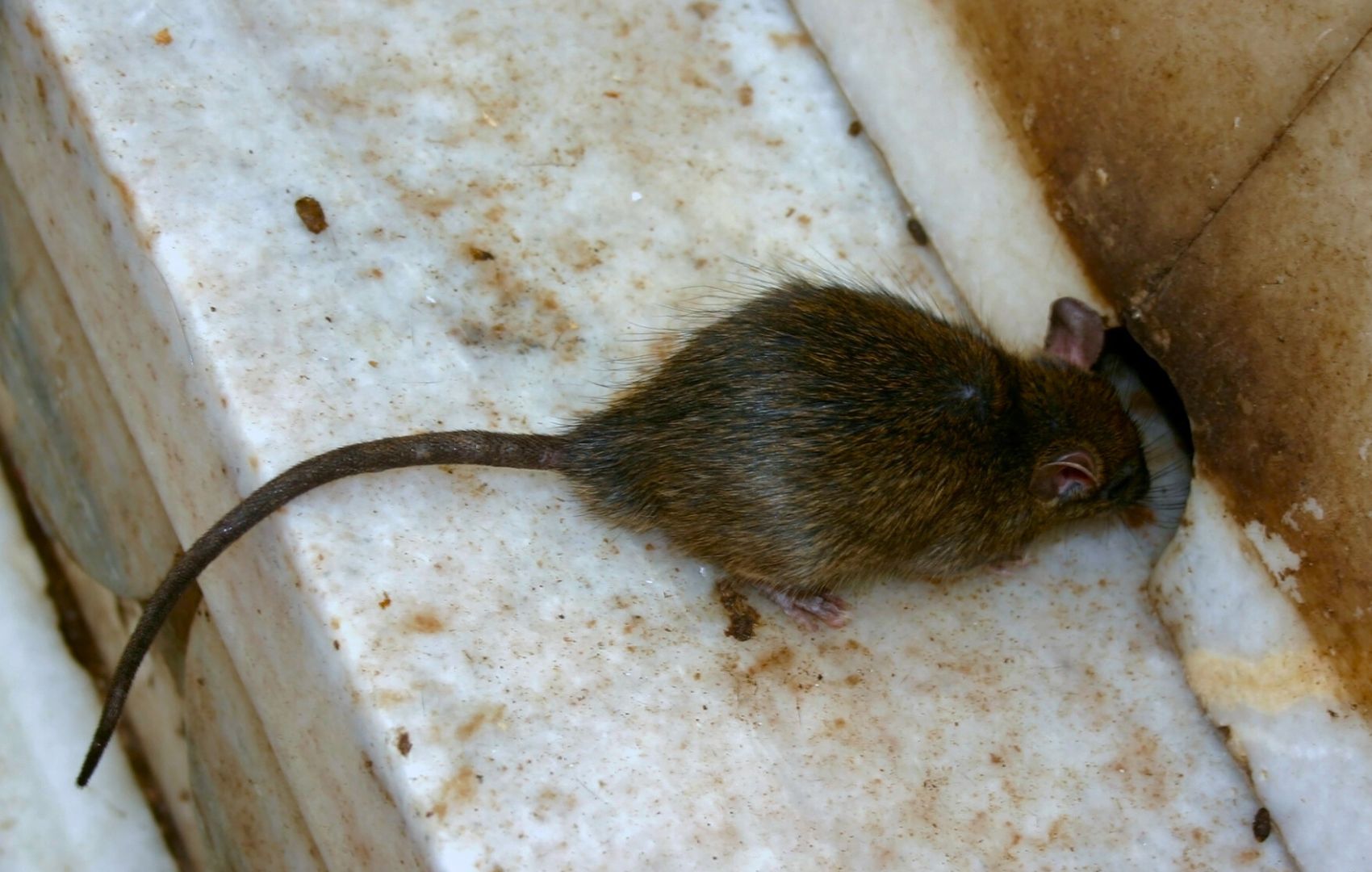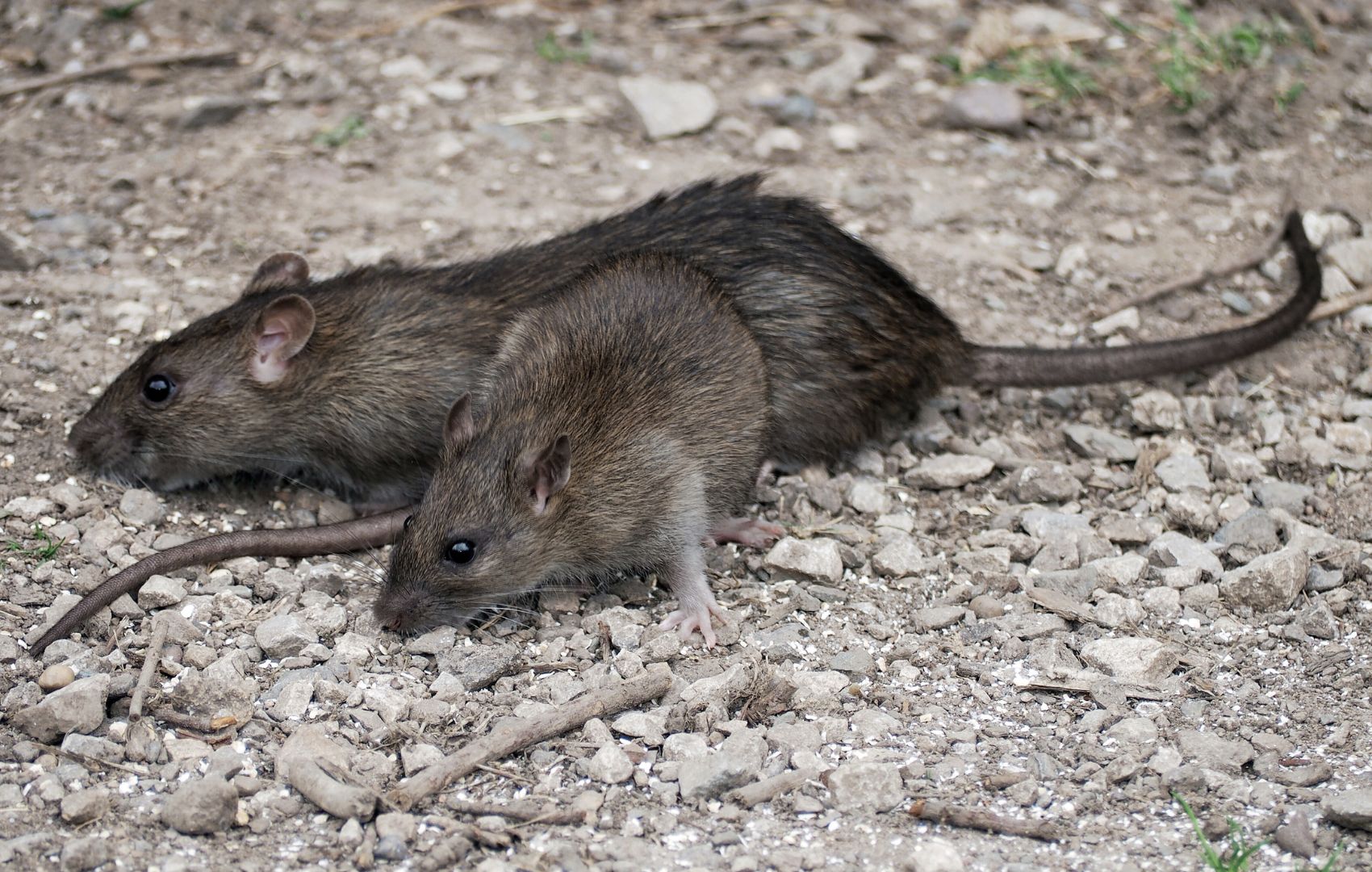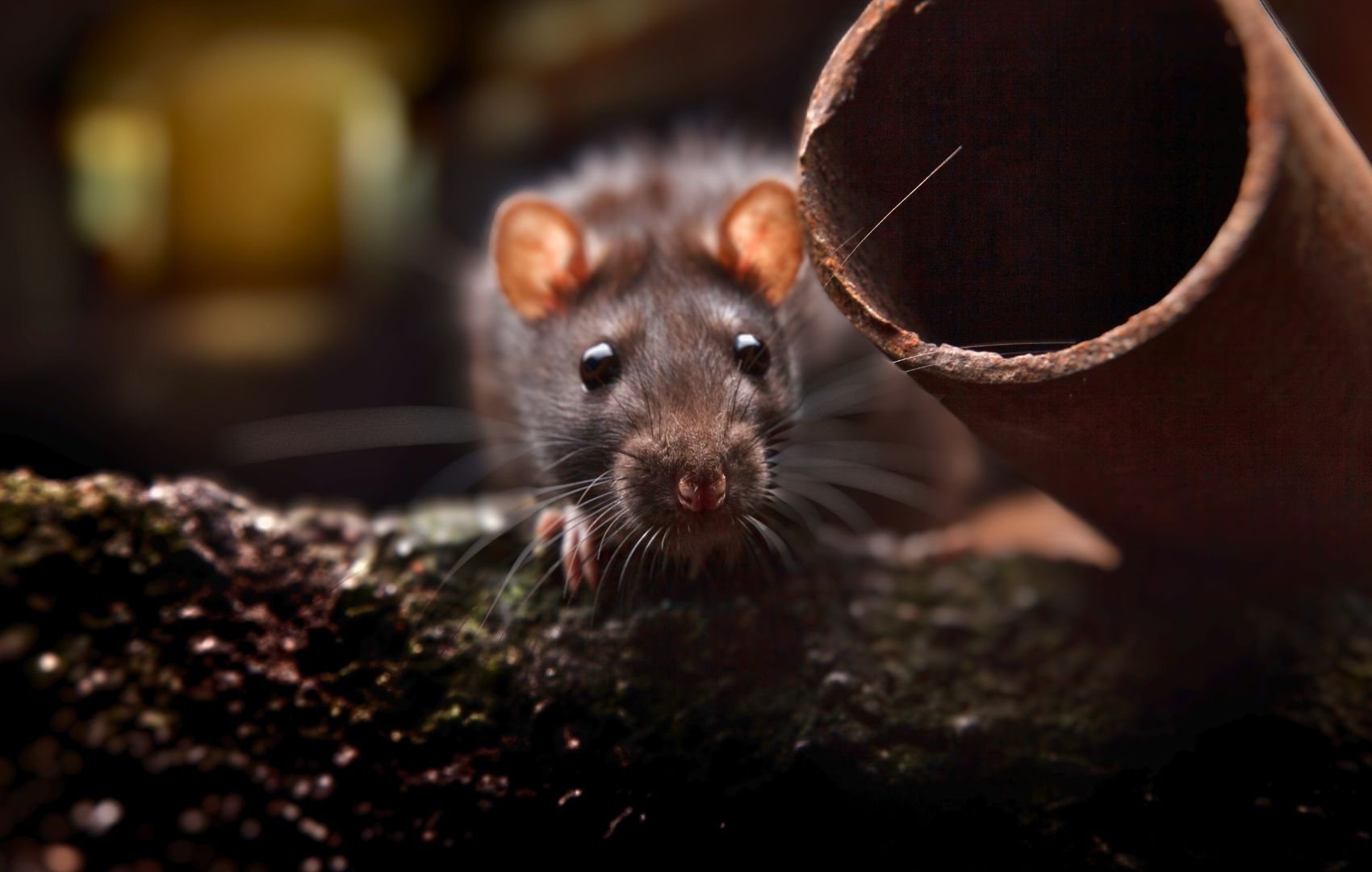Roof Rats Lodi | Must Know Lodi Rodent and Roof Rat Dangers
Lodi roof rats are one of the two types of rats in the lower 48 states. The roof rat (Rattus rattus), also called the black rat or ship rat, has a fascinating history as a plague carrier and was frequently found on early sailing ships. They arrived in North America via sea.
Physical Characteristics and Behavioral Traits of Roof Rats
It is a medium-sized rat with relatively large ears and a tail that is longer than its body. Other physical features include being warm-blooded and symmetrical.
Roof rats have soft and smooth brown fur intermixed with black. Their underside can be white, gray, or black. Some of these rats have black fur and a gray belly. Other roof rats with brown coats and gray streaks have gray or white bellies.
Roof rats have a body 6 to 8 inches long with a scaled tail of 7.5 to 8 inches, totaling about 16 inches. Their weight varies between 5 and 9 ounces but can reach up to 12 ounces. Males are longer and heavier than females.
Rat Breeding Habits in Lodi, CA
Roof rats form social groups with multiple males and females. In these groups, females are more aggressive than males and will fiercely defend their territories and mate. Roof rats are polygynous, living in groups consisting of one dominant male who copulates with two to three dominant females that make up the group.
If environmental conditions permit, breeding can occur year-round, but summer and fall are peak breeding seasons. Females can give birth to up to 5 liters per year with an average of 8 offspring, ranging from 6 to 12. The gestation period lasts between 21 and 29 days, and young rats can reproduce within 3 to 5 months after birth. It is essential to note that roof rats cannot interbreed with Norway rats or any other native rodent species to maintain their genetic integrity.
Rat Habitat and Diet
Roof rats are common rodents that can infiltrate a home, commercial property, and other areas of human habitation. Roof rats are nocturnal animals that tend to move above ground, making them particularly difficult to control. These rats climb up from a yard to the upper floors of buildings, leaping from one tree to another or onto roofs, traveling along utility wires. Its tail is longer than its body and helps it balance while climbing.
As agile climbers, they prefer high places inside a home or commercial building, such as attics and ceilings for nesting. They usually build their nests of leaves and twigs in trees, shrubs, or amid vines.
Rattus rattus is mainly found in large numbers in coastal areas because it spreads through human shipping. It can live in any area with enough food for its mainly vegetarian diet. Diet includes fruits, vegetables, grains, occasional insects, and rarely other small animals.
Lodi Roof Rat Dangers
Whether inside or outside, Lodi roof rats are destructive. When outside 9in the yard, they strip the bark off trees. Indoors, these rats contaminate human and pet food, spread disease, and damage property.
These rats can fit through exceedingly small openings, such as holes the size of a quarter, making it easy to get inside any building. Therefore, sealing openings, including small cracks and holes, is essential to keep roof rats out. Keep all food and garbage sealed in containers and eliminate sources of standing water.
The roof rat is a type of rodent that can be a danger to humans and pets. They can spread diseases that cause symptoms like fever, muscle pain, vomiting, diarrhea, and rash. People can get sick from coming into contact with the rat’s urine, poop, or other fluids or from consuming contaminated food or water. Although most people will recover on their own, some cases can be very serious or even deadly if not treated with medicine.
When it comes to rodents, they are known carriers of various diseases. Some of the diseases that rodents can transmit to humans include:
-
Hantavirus: This potentially fatal respiratory disease is transmitted through rodent urine and droppings.
-
Salmonella: This type of food poisoning can be caused by ingesting food contaminated with rodent feces.
-
Rat-bite fever: This bacterial infection can be transmitted through a bite or scratch from an infected rodent.
-
Leptospirosis: This bacterial infection can be transmitted through contact with water or soil contaminated with rodent urine.
-
Plague: This is a severe bacterial infection that can be transmitted through fleas carried by rodents.
It’s essential to take rodent infestations seriously and take steps to eliminate them as soon as possible to prevent the spread of disease. Rats and mice carry diseases that they can transmit to humans. These diseases spread through direct contact with rodents, such as handling or through contact with their feces, urine, or saliva. It’s also possible to contract a disease by breathing in air or eating food contaminated with rodent waste. Rodents can also carry ticks, fleas, and mites that can spread diseases between rodents and humans. Unfortunately, many diseases do not show any symptoms in rodents, making it challenging to determine by sight whether a rodent is diseased.
Prevent and Control Rat Infestations on Your Property
The primary reason for the spread of diseases from rodents to humans is the infestation of rodents in and around the home. The best way to prevent rodent infestation and the spread of disease is to remove food, water, and shelter sources for rodents. Learning how to eliminate rodent infestation, prevent future rodent infestations, and protect yourself from diseases spread by rodents is essential.
Signs of Lodi Rodent Infestation
The first signs of rodents often become noticeable before you even spot a rat or mouse. You are inspecting the interior and exterior of your home or business to detect any indications of rodents. Controlling rodents before they have a chance to settle is much simpler.
Rodents are experts at avoiding humans by living behind walls, under floorboards, or in attics during the day. They usually come out at night when it’s dark and difficult to spot. Although they are challenging to track and catch, they leave behind marks that can help guide you in capturing them. Here are ways they leave their mark during their nocturnal scavenges. Two typical indications of rodent presence are droppings and gnaw marks.
-
Gnaw Marks
Did you know that rat teeth are constantly growing? So help! Managing this growth is a matter of life and death for rats. Their teeth can grow to be a foot long in just two years and cause them to starve to death. To keep their teeth in check, rats must gnaw on anything they can find, including plastic, brick, copper, cement, and steel.
Rats and mice naturally tend to gnaw, which helps them create better access points and keep their teeth at the proper length. These gnaw marks are often visible and are a good indicator of rodent activity in the area. Rodents are the number one suspects in about 20 percent of house fires of undetermined cause in the United States. If you suspect the presence of rodents, you might want to check doorways and other entry points for gnaw marks.
-
Droppings
Rodents tend to leave their droppings everywhere they go. So, their droppings can be anywhere rodents have access. Still, they are most commonly in hidden dark places like cabinets and drawers. The droppings have a pointed end and often contain hair. The dropping size, shape, and texture can determine which rodents are present, their diet, and whether there is an active infestation. Rats produce around 20 to 50 droppings daily, while mice produce about 40 to 100 droppings daily.
-
Sebum
Like humans, rats and mice produce natural oils on their skin and hair. As they travel their familiar routes, they leave behind oils and dirt from their fur along walls and baseboards, known as sebum marks. These marks look like grease stains and indicate a highly trafficked rodent runway. You can spot sebum marks indoors and outdoors, especially near entryways or along pipes, telephone wires, and gutters.
-
Burrows and Structural Holes
 As mentioned, rodents remain hidden and prefer to stay close to food and water sources. Rats usually reside within a distance of 90-450 feet from their food source. On the other hand, mice have varying distances from their food source. However, a typical house mouse lives 10-30 feet away from their food source.
As mentioned, rodents remain hidden and prefer to stay close to food and water sources. Rats usually reside within a distance of 90-450 feet from their food source. On the other hand, mice have varying distances from their food source. However, a typical house mouse lives 10-30 feet away from their food source.
Diseases Spread by Rodents and Preventive Measures
Rodents such as rats are known carriers of many diseases that can harm humans. These diseases can be transmitted either directly or indirectly from rodents.
Avoid Direct Contact with Rodents
 Knowing that deadly diseases can pass from rodents to humans is critical. Humans can contract diseases through direct contact with infected rodents. Touching infected rats or being bitten or scratched by one can transmit diseases to you.
Knowing that deadly diseases can pass from rodents to humans is critical. Humans can contract diseases through direct contact with infected rodents. Touching infected rats or being bitten or scratched by one can transmit diseases to you.
But that is not the only way. There are many other ways rodents can directly pass diseases to humans. Anything touched by infected rats can be contaminated with disease. So, where rats live, nest, feed, and breed are contaminated areas. Mere exposure to these soiled areas is enough for you to contract a horrible life-changing disease.
Simply inhaling contaminated air near an infected rat’s nest can make you ill. Also, touching contaminated rodent nesting materials and then touching your eyes, nose, or mouth can pass diseases from infected rodents to you. In addition, you are at risk when encountering an infected rodent’s saliva, urine, or feces. Even consuming food that an infected rodent contaminates can transmit a disease to you.
It is crucial to take necessary precautions to prevent the spread of such diseases, including keeping living spaces clean and free of rodents and avoiding contact with rodents, their droppings, and contaminated materials.
Be Aware of Indirect Contact
It is essential to know that disease can spread from rodents to humans not only by direct contact but also through indirect contact. Therefore, taking necessary precautions to protect yourself from these health risks is crucial. However, it is essential to understand how humans can come into indirect contact with infected rats.
Indirect contact with infected rats can happen when bloodsucking insects or arachnids bite infected rats. After feeding on an infected rodent, a tick, mite, flea, or mosquito bite can transmit diseases to humans.
According to the CDC, certain diseases can spread from rodents to people through indirect contact. It can occur when ticks, mites, fleas, and mosquitos feed on infected rodents before biting people. Diseases can also spread to people from rodents through the consumption of an intermediate host (for example, beetles or cockroaches).
- Colorado tick fever
- Flea-borne (Murine) Typhus
- Lyme disease
- Plague
- Tick-borne Relapsing Fever
Roof Rat FAQ for Lodi’s Residents
What is the fastest way to get rid of roof rats?
To effectively get rid of roof rats quickly, consider the following steps:
- Eliminate Food Sources: Keep food in airtight containers, clean up spills, and secure trash bins.
- Seal Entry Points: Inspect your home for gaps and holes, especially around roof vents, and seal them to prevent rats from entering.
- Use Traps: Snap traps and electronic traps can be effective. Bait them with peanut butter or dried fruit and place them in areas where you’ve seen signs of rats.
- Professional Extermination: If the problem persists, hiring a pest control professional may be the fastest solution.
Are roof rats common in California?
Roof rats are quite common in many parts of California, particularly in urban areas. They thrive in warmer climates and are frequently found in homes, attics, and garages.
What time are roof rats most active?
Roof rats are primarily nocturnal, meaning they are most active at night. They typically come out after sunset to forage for food and water.
Are roof rats covered by insurance?
Coverage may vary by policy, so checking your homeowner’s insurance is best. Some policies may cover pest control or damage caused by rodents, while others may not. It’s important to read the fine print and contact your insurance provider for clarification.
Why is the roof rat so common?
This rat lives mostly outside and can find plenty of food in Lodi year-round.
Where might you encounter or notice a roof rat?
Typically, a rat of this type will be in your yard. They like to run along fence lines at night. You may notice activity inside a garage or shed and then in the attic.
Is there anything you can do to keep roof rats away?
Remove potential food sources that are outside your home that attract rodents. For instance, remove all fruit dropped from trees, bird seed, slugs, and snails from your yard to avoid attracting rats.
Lodi Pest Control Services for Rats, Mice, and More

If you may have a roof rat infestation, contact a Local Pest Solutions pest control professional for assistance. We are home and commercial pest control experts with affordable services. Our pest control service gets rid of all pests in the Lodi, CA area. Contact us for home pest control services, commercial pest control services, and bed bug pest control services. We also offer services for ant pest control, spider pest control, and cockroach pest control. In addition, we provide wasp control services, hornet pest control, tick control services, and flea treatment control service. Our subscription pest control service is also available in Lodi, CA.
We provide pest control services for both home and commercial properties in Lodi. Rats continue to infest properties, and DIY methods may not always be the best long-term solution. Our integrated pest management pest control services guarantee we will solve your problem.
With our integrated pest management pest control, we remove pests and inspect and identify vulnerable spots that make your property prone to another pest infestation. We also recommend pest prevention practices and safeguards to prevent more pests from taking over. You can opt for a one-time extermination pest control service or scheduled pest control treatment plans. Regardless of your chosen service, you can expect reliable and effective pest control from Local Pest Solutions. Call 209-309-7378 for a free inspection and quote for pest control services.
